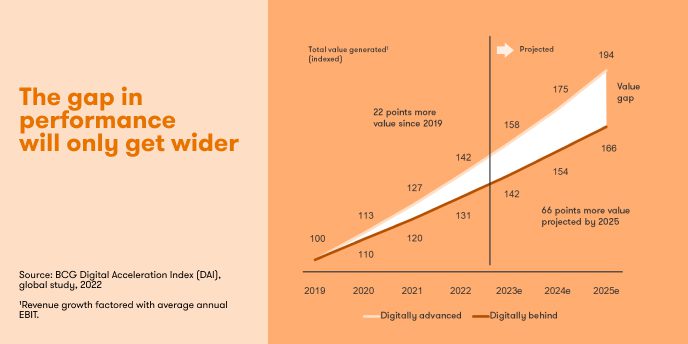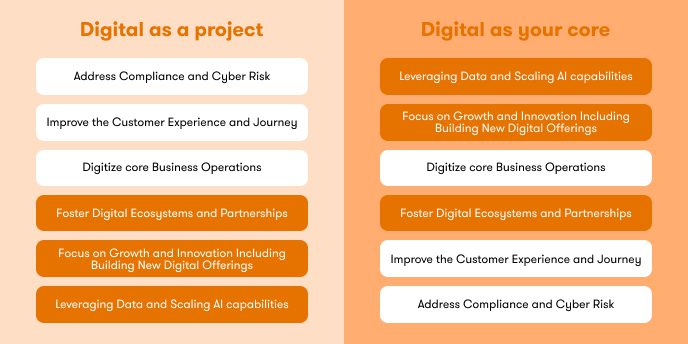

There are three big trends I want to highlight today. Firstly, there is the evolution of connectivity everywhere and of everything; secondly, we have the inexorable rise of data and the subsequent complexity emerging from that; and finally there is the explosion in tech-enabled productivity tools like generative AI.
Because of this, we’re going to make a rare exception in this article and expand on the Trackunit position towards the ‘pace of learning’ as the overall theme underpinning these three trends. We see this as the big development that will become increasingly mainstream in 2024 and dominate in the years to come. It will be critical for your business — especially if you are in the off-highway sector — and that’s why we want to highlight why it matters.
Let’s start with some pivotal research. Technology and consulting firm Gartner said in a report in November 2023 that global end-user spending on public cloud services would grow by 20.4% in 2024 to circa $679 billion, a $115bn rise on 2023. That prompted Sid Nag, Vice President Analyst at Gartner, to speak of a scenario where “cloud models no longer drive business outcomes, but rather, business outcomes shape cloud models”.
A significant proportion of that spending would subsequently become much more tailored leading to a scenario where by 2027, “more than 70% of enterprises will use industry cloud platforms to accelerate their business initiatives, up from less than 15% in 2023”, Gartner added.
Industry cloud platforms is the key here. If we briefly cast a glance back at 2023, we very much pushed the theme that OEMs, Rentals and Contractors have to look, think and act like software companies if they are to compete and grow in a digital world. That hasn’t changed.
Indeed, the gap between digitally advanced companies and those who veer towards more traditional ways of doing things will only grow as indicated by the BCG Digital Acceleration Index that illustrates how the ‘value gap’ between so-called ‘digitally advanced’ and ‘digitally behind’ is growing.

But Gartner’s findings also point to complications for business in 2024 that will require adaption. While becoming more connected has in many ways simplified our personal lives, it has also added layers of complexity for businesses given the billions of data points we are generating by the minute.
That calls for the kind of industry-specific Cloud model of the future that offers solutions tailored to the particular needs of any given industry, enabling businesses to get the data and services from a Cloud platform that is more intuitively adapted to their requirements.
That AI is partly responsible for adding layers of complexity will not come as surprise, but AI and machine learning will also inevitably become part of the solution. In fact, the new logic of competitiveness will be based on how fast organizations can assimilate AI and run with the pace of learning. In order to do that, there’s a number of things they will need to do.
Firstly, the notion that everything is about people, processes and systems is the only way to scale our organizations, needs a reboot. This symbiotic relationship will continue to matter of course but in the new era of AI and data, it requires a mind shift from ‘know-it-all’ to ‘learn-it-all’.
“The notion that everything is about people, processes and systems is the only way to scale our organizations, needs a reboot.”
People, processes and systems remain super relevant but they alone will not help an organization increase its pace of learning. Any incremental acceleration in the pace of learning will come from the utilization of data and AI in harmony with autonomous execution, autonomous systems and workflows.
What does that entail? It means that instead of having your digital ambitions sequestered away in a separate project running parallel to your main business, your digital operations must become absolutely and fully integrated into your business operations.
With digital at the very core of your DNA, it changes the dynamic dramatically. The graphic below highlights this explicitly. A digital project might prioritize addressing compliance and cyber risk and improving the customer experience and journey over, for example, leveraging data and scaling AI capabilities. But a core-digital model would, and I use this word deliberately, completely disrupt that traditional hierarchy.

In the digital-as-your-core model, leveraging data and scaling AI capabilities suddenly jumps from bottom of the table to top and compliance and cyber risk, while obviously still remaining very important, slides to the foot of the table.
The key here is that your Operating Data Platform helps nurture an ecosystem where all these significant drivers are valued, even if the hierarchy changes. That is exactly what we have set out to do with Trackunit Iris. Whether Iris yet qualifies as the type of Industry Cloud Platform Gartner highlighted might be a point of debate, but it has that aspiration and it is already leveraging AI to provide the difference at the margins be it in access management, emissions reporting or other areas relevant to the off-highway sector.
In revenue terms, the possibilities are stark. We estimate that a digital project might typically enhance your business revenues by a 1-2 times. A business that successfully adopts a digital-at-its-core business model, however, has the potential to grow 10-20 times bigger.
“We estimate that a digital project might typically enhance your business revenue by 1-2 times. A business that successfully adopts a digital-at-its-core business model, however, has the potential to grow 10-20 times bigger.”
But that’s not a given. It will all be down to how you execute the shift to leveraging AI and data and make it work for you. And software experts like us who have their Operating Data Platform in place are there to help. Execute well, and you’re in the vanguard. Do it badly and you could be playing permanent catch-up.
This may feel like a ‘sell’, but the paradigm shift here is so significant that we think we’d be remiss not to be absolutely clear in our language. The good news is that the help is out there and a lot of companies are doing amazing things helping businesses understand what they need to do and how they can adapt to the pace of learning. Whether it’s about fostering product innovation, collaboration models, business impact or indeed finding a way of fusing all three, it’s about building insights for construction that makes a difference.
That will drive more efficiency, faster digital ecosystems based on real partnerships with a focus on growth, and innovation that will enable new digital offerings to emerge underpinned by data and the scaling of AI.
Driving business impact is the fundamental imperative and that will only come from putting digital at the core of everything you do. On the jobsite, that will naturally manifest in full-equipment connectivity to ensure fleet owners are making the absolute best of their assets.
Early adapters in all lines of business, including construction, will be the big winners here. Will you be one of them?
This is the first in a series of articles on the role of Industry Cloud Platforms and how they will change the way we do business over the next few years.

